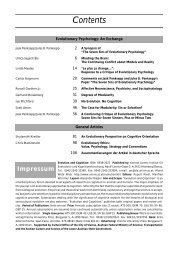Contents - Konrad Lorenz Institute
Contents - Konrad Lorenz Institute
Contents - Konrad Lorenz Institute
You also want an ePaper? Increase the reach of your titles
YUMPU automatically turns print PDFs into web optimized ePapers that Google loves.
Michel A. Hofman<br />
Of Brains and Minds<br />
A Neurobiological Treatise on the Nature of Intelligence<br />
Brain, Mind<br />
and Reality<br />
Organisms are faced during<br />
their lives with an immense<br />
variety of problems,<br />
ranging from<br />
purely physical ones,<br />
such as changes in climate<br />
or geomorphic disturbances,<br />
to organismspecific<br />
problems related<br />
to food supply, predation,<br />
homeostasis, reproduction,<br />
etc. In order to enhance<br />
their chances of<br />
survival, organisms have<br />
to find adequate solutions<br />
for the problems<br />
with which they are confronted,<br />
for any of them<br />
could easily be fatal.<br />
Problem solving, in other<br />
words, is an essential dynamic<br />
survival mechanism, evolved to cope with<br />
disturbances in the ecological equilibrium. It can<br />
therefore be looked upon as an adaptive capacity<br />
enabling organisms to adjust themselves to one another<br />
and to their physical environment.<br />
The kind of problems with which organisms are<br />
confronted, however, and their relative significance,<br />
varies from one species to another, according<br />
to the ecological niche or adaptive zone that it occupies.<br />
These specific environmental challenges form<br />
the selection pressures that have given rise to the<br />
evolution of species-specific neural mechanisms<br />
and action patterns. In fact all organisms are problem<br />
solvers, and the problem solving capacity of a<br />
Abstract<br />
All organisms are faced during their lives with an immense<br />
variety of environmental challenges and organism<br />
specific problems, for which they have to find<br />
adequate solutions, in order to survive. In the present<br />
essay, biological intelligence is considered to be a correlate<br />
of the problem solving capacity of an organism,<br />
manifesting itself in the amount of neural information<br />
that is used in perceiving and interpreting the external<br />
(and internal) world. Consequently, biological<br />
intelligence can be conceived as to reflect the temporal<br />
and spatial complexity of the species niche. In accordance<br />
with this view, the hypothesis is put forward<br />
that in higher organisms the complexity of the neural<br />
(micro)circuitry of the cerebral cortex is the neural correlate<br />
of the brain's coherence and predictive power,<br />
and, thus, a measure of biological intelligence.<br />
Key words<br />
Biological intelligence, information processing, consciousness,<br />
problem solving, cognition, cerebral cortex,<br />
evolutionary epistemology.<br />
Evolution and Cognition ❘ 178 ❘ 2003, Vol. 9, No. 2<br />
species reflects the temporal<br />
and spatial complexity<br />
of its environment.<br />
Consequently, the<br />
ability to solve problems<br />
will manifest itself in all<br />
those situations in which<br />
subjects are required to<br />
respond adequately to<br />
novel objects and changing<br />
circumstances, as well<br />
as in situations in which<br />
successful adaptation involves<br />
the detection of an<br />
appropriate response to<br />
regularities in the external<br />
world or the formation<br />
of rules and hypotheses<br />
(POPPER 1982;<br />
HODOS/CAMPBELL 1990;<br />
MACPHAIL 1993; SHETTLE-<br />
WORTH 1998). Environmental<br />
adaptation, therefore,<br />
can be considered to<br />
be the primary function<br />
of problem solving in that it serves as a preeminent<br />
mechanism for survival.<br />
The organism’s adaptability, however, is but one<br />
aspect of fitness. Free-moving organisms, for example,<br />
can actively explore their environment, and<br />
thus generate new selection forces that can modify<br />
the structures involved. MAYR (1982, p612) even argues<br />
that ‘many if not most acquisitions of new<br />
structures in the course of evolution can be ascribed<br />
to selection forces by newly acquired behaviors’.<br />
This suggests that in highly complex organisms,<br />
such as mammals, behavior rather than environmental<br />
change may be the major driving force for<br />
evolution at the organismal level. However, this








